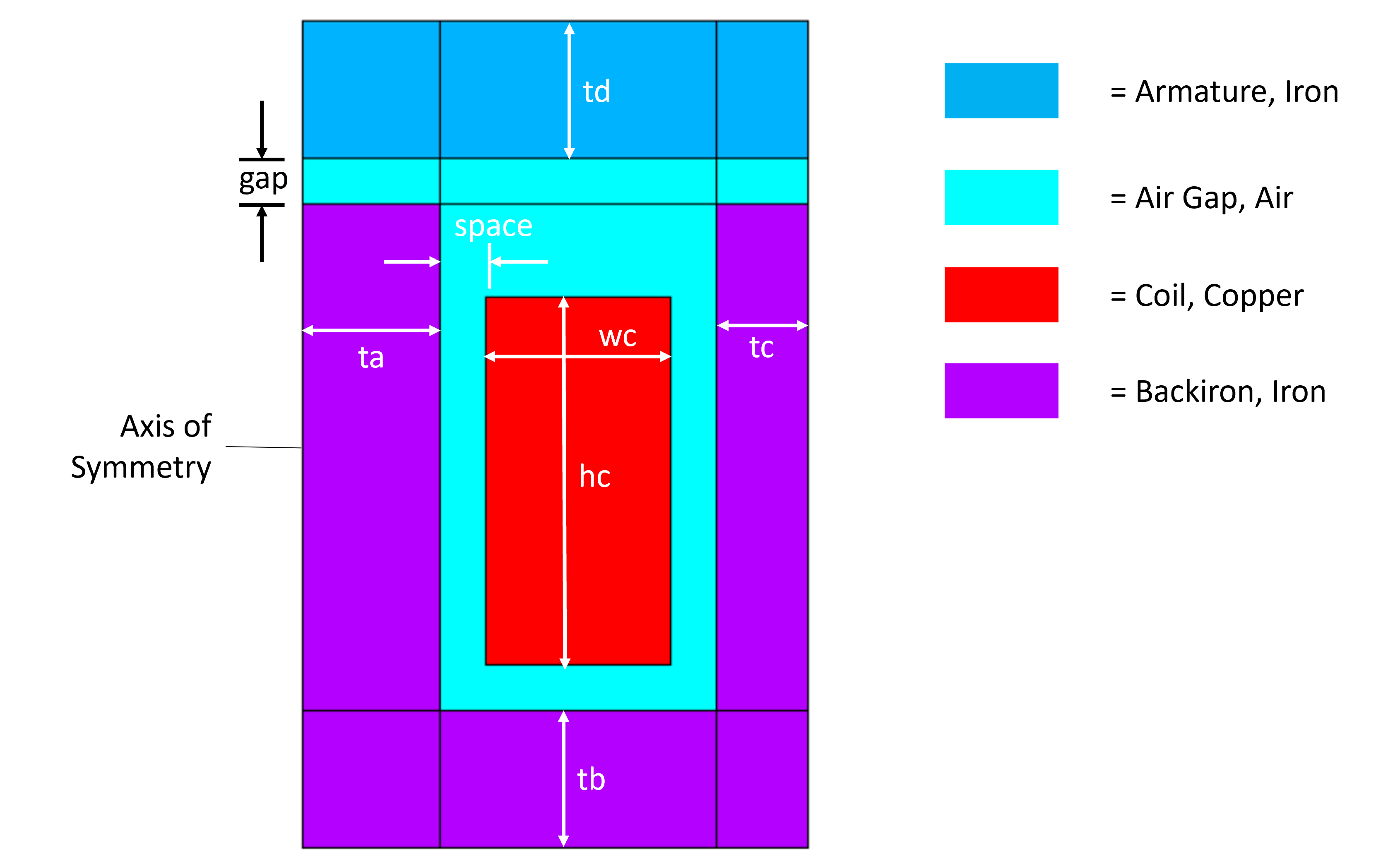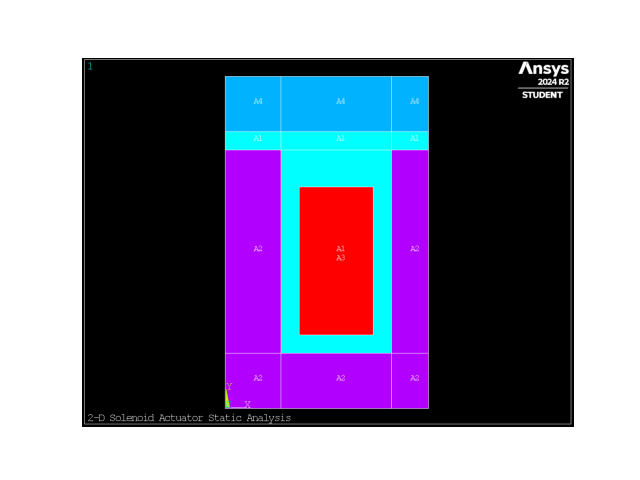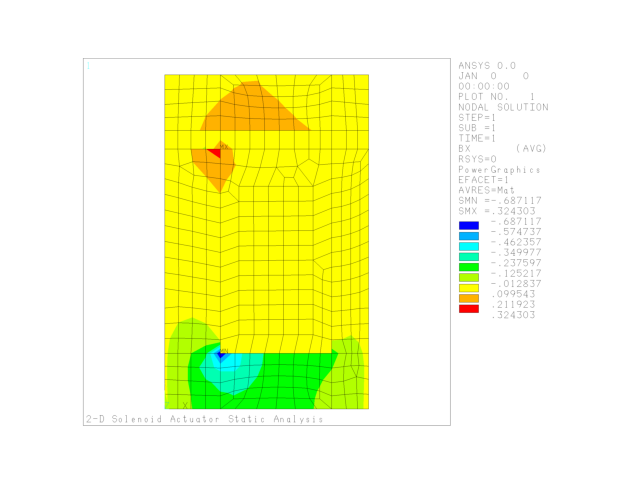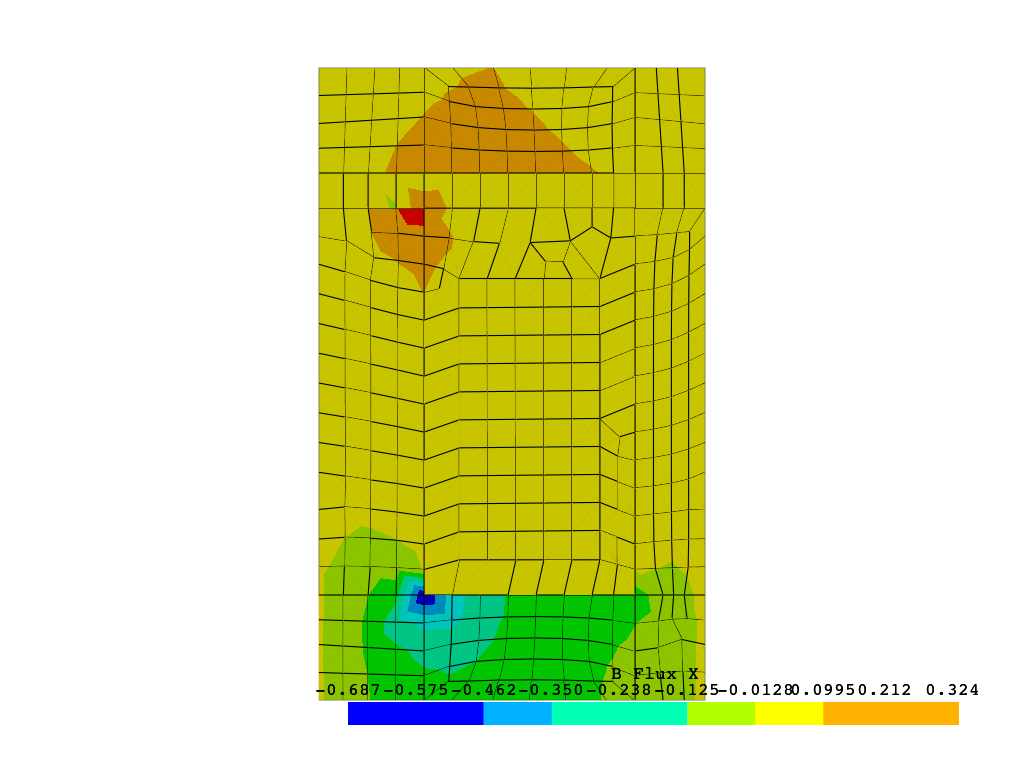Note
Go to the end to download the full example code.
Analysis of a 2D magnetostatic solenoid#
This example shows how to gather and plot results with material discontinuities across elements (Power graphics style) versus the default full average results (Full graphics style).
Description#
Mechanical APDL has two averaging methods for presenting results. The following descriptions indicate the primary differences, although other differences exist.
Full graphics: Presents the entire selected model with node averaged results. In the case of a node shared by two or more elements that have differing materials, the stress field is continuous across the element material boundary (the shared nodes).
Power graphics: Presents the entire selected model with averaged results within elements of the same material and discontinuous across material boundaries.
This example focuses on material boundaries.
Native PyMAPDL postprocessing is like MAPDL’s Full graphics method with respect to material boundaries.
The geometry of the solenoid is given in Figure 1.

Figure 1: Solenoid geometry description.#
Loads and boundary conditions#
The coil has a current density applied equal to 650 turns at 1 amp per turn. All exterior nodes have their Z magnetic vector potential set to zero, enforcing a flux parallel condition.
Import modules#
In addition to the usual libraries, Matplotlib and PyVista are imported. The MAPDL default contour color style is used so Matplotlib is imported. The Power Graphics style plot is then set up via PyVista.
import numpy as np
import pyvista as pv
from ansys.mapdl.core import launch_mapdl
from ansys.mapdl.core.plotting import GraphicsBackend
Launch MAPDL service#
mapdl = launch_mapdl()
mapdl.clear()
mapdl.prep7()
mapdl.title("2-D Solenoid Actuator Static Analysis")
TITLE=
2-D Solenoid Actuator Static Analysis
Set up the FE model#
Define parameter values for geometry, loading, and mesh sizing. The model is built in centimeters and is then scaled to meters.
The element type ‘Plane233’ is used for 2D magnetostatic analysis.
mapdl.et(1, "PLANE233") # Define PLANE233 as element type
mapdl.keyopt(1, 3, 1) # Use axisymmetric analysis option
mapdl.keyopt(1, 7, 1) # Condense forces at the corner nodes
ELEMENT TYPE 1 IS PLANE233 AXI 8-NODE MAGNETIC SOLID
KEYOPT( 1- 6)= 0 0 1 0 0 0
KEYOPT( 7-12)= 1 0 0 0 0 0
KEYOPT(13-18)= 0 0 0 0 0 0
CURRENT NODAL DOF SET IS AZ
AXISYMMETRIC MODEL
Set material properties#
Units are in the international unit system.
mapdl.mp("MURX", 1, 1) # Define material properties (permeability), Air
mapdl.mp("MURX", 2, 1000) # Permeability of backiron
mapdl.mp("MURX", 3, 1) # Permeability of coil
mapdl.mp("MURX", 4, 2000) # Permeability of armature
MATERIAL 4 MURX = 2000.000
Set parameters#
Set parameters for geometry design.
n_turns = 650 # Number of coil turns
i_current = 1.0 # Current per turn
ta = 0.75 # Model dimensions (centimeters)
tb = 0.75
tc = 0.50
td = 0.75
wc = 1
hc = 2
gap = 0.25
space = 0.25
ws = wc + 2 * space
hs = hc + 0.75
w = ta + ws + tc
hb = tb + hs
h = hb + gap + td
acoil = wc * hc # Cross-section area of coil (cm**2)
jdens = n_turns * i_current / acoil # Current density (A/cm**2)
smart_size = 4 # Smart Size Level for Meshing
Create geometry#
Create the model geometry.
mapdl.rectng(0, w, 0, tb) # Create rectangular areas
mapdl.rectng(0, w, tb, hb)
mapdl.rectng(ta, ta + ws, 0, h)
mapdl.rectng(ta + space, ta + space + wc, tb + space, tb + space + hc)
mapdl.aovlap("ALL")
mapdl.rectng(0, w, 0, hb + gap)
mapdl.rectng(0, w, 0, h)
mapdl.aovlap("ALL")
mapdl.numcmp("AREA") # Compress out unused area numbers
COMPRESS AREA NUMBERS
MAXIMUM AREA NUMBER COMPRESSED FROM 18 TO 13
Mesh#
Set the model mesh.
mapdl.asel("S", "AREA", "", 2) # Assign attributes to coil
mapdl.aatt(3, 1, 1, 0)
mapdl.asel("S", "AREA", "", 1) # Assign attributes to armature
mapdl.asel("A", "AREA", "", 12, 13)
mapdl.aatt(4, 1, 1)
mapdl.asel("S", "AREA", "", 3, 5) # Assign attributes to backiron
mapdl.asel("A", "AREA", "", 7, 8)
mapdl.aatt(2, 1, 1, 0)
mapdl.pnum("MAT", 1) # Turn material numbers on
mapdl.allsel("ALL")
mapdl.aplot(graphics_backend=GraphicsBackend.MAPDL)

Mesh
mapdl.smrtsize(smart_size) # Set smart size meshing
mapdl.amesh("ALL") # Mesh all areas
GENERATE NODES AND ELEMENTS IN ALL SELECTED AREAS
** AREA 5 MESHED WITH 54 QUADRILATERALS, 1 TRIANGLES **
** AREA 6 MESHED WITH 54 QUADRILATERALS, 0 TRIANGLES **
NUMBER OF AREAS MESHED = 13
MAXIMUM NODE NUMBER = 1166
MAXIMUM ELEMENT NUMBER = 365
Scale mesh to meters#
Scale the model to be one meter in size.
mapdl.esel("S", "MAT", "", 4) # Select armature elements
mapdl.cm("ARM", "ELEM") # Define armature as a component
mapdl.allsel("ALL")
mapdl.arscale(na1="all", rx=0.01, ry=0.01, rz=1, imove=1) # Scale model to MKS (meters)
mapdl.finish()
***** ROUTINE COMPLETED ***** CP = 0.000
Loads and boundary conditions#
Define loads and boundary conditions.
mapdl.slashsolu()
# Apply current density (A/m**2)
mapdl.esel("S", "MAT", "", 3) # Select coil elements
mapdl.bfe("ALL", "JS", 1, "", "", jdens / 0.01**2)
mapdl.esel("ALL")
mapdl.nsel("EXT") # Select exterior nodes
mapdl.d("ALL", "AZ", 0) # Set potentials to zero (flux-parallel)
SPECIFIED CONSTRAINT AZ FOR SELECTED NODES 1 TO 1166 BY 1
REAL= 0.00000000 IMAG= 0.00000000
Solve the model#
Solve the magnetostatic analysis.
mapdl.allsel("ALL")
mapdl.solve()
mapdl.finish()
FINISH SOLUTION PROCESSING
***** ROUTINE COMPLETED ***** CP = 0.000
Postprocessing#
Open the result file and read in the last set of results
mapdl.post1()
mapdl.file("file", "rmg")
mapdl.set("last")
USE LAST SUBSTEP ON RESULT FILE FOR LOAD CASE 0
SET COMMAND GOT LOAD STEP= 1 SUBSTEP= 1 CUMULATIVE ITERATION= 1
TIME/FREQUENCY= 1.0000
TITLE= 2-D Solenoid Actuator Static Analysis
Print the nodal values
print(mapdl.post_processing.nodal_values("b", "x"))
[-0.21167925 -0.08883214 0.04409027 ... 0. 0.
0. ]
Create an MAPDL Power Graphics plot of the X-direction magnetic flux#
The MAPDL colors are reversed via the rgb command so that the background is
white with black text and element edges.
mapdl.graphics("power")
mapdl.rgb("INDEX", 100, 100, 100, 0)
mapdl.rgb("INDEX", 80, 80, 80, 13)
mapdl.rgb("INDEX", 60, 60, 60, 14)
mapdl.rgb("INDEX", 0, 0, 0, 15)
mapdl.edge(1, 1)
mapdl.show("png")
mapdl.pngr("tmod", 0)
mapdl.plnsol("b", "x")
mapdl.show("")

/SHOW SWITCH PLOTS TO PNG - RASTER MODE.
Obtain grid and scalar data#
First, obtain the set of unique material IDs in the model
array([1, 2, 3, 4], dtype=int32)
For each unique material ID, the elements and their nodes are selected.
The grids list is appended with the mesh information of just those
elements, and the scalars list is appended with the nodal X-direction magnetic
flux.
SELECT ALL ENTITIES OF TYPE= ALL AND BELOW
If interested print the grids list and perhaps compare to a print of mapdl.mesh.grid
print(grids)
# print(mapdl.mesh.grid)
[UnstructuredGrid (0x7f23b6f62020)
N Cells: 69
N Points: 297
X Bounds: 0.000e+00, 2.750e-02
Y Bounds: 7.500e-03, 3.750e-02
Z Bounds: 0.000e+00, 0.000e+00
N Arrays: 10, UnstructuredGrid (0x7f23b6f62740)
N Cells: 180
N Points: 631
X Bounds: 0.000e+00, 2.750e-02
Y Bounds: 0.000e+00, 3.500e-02
Z Bounds: 0.000e+00, 0.000e+00
N Arrays: 10, UnstructuredGrid (0x7f23b6f62f80)
N Cells: 50
N Points: 181
X Bounds: 1.000e-02, 2.000e-02
Y Bounds: 1.000e-02, 3.000e-02
Z Bounds: 0.000e+00, 0.000e+00
N Arrays: 10, UnstructuredGrid (0x7f23b6f63580)
N Cells: 66
N Points: 235
X Bounds: 0.000e+00, 2.750e-02
Y Bounds: 3.750e-02, 4.500e-02
Z Bounds: 0.000e+00, 0.000e+00
N Arrays: 10]
Color map and result plot#
Because some of the MAPDL contour colors do not have an exact match in the standard Matplotlib color library, an attempt is made to match the color and use the Hex RGBA number value.
For each item in the grids list the grid is added to the plot and 9 contour colors requested using the prior define color map and the same contour legend.
The plot is then shown and it recreates the native plot quite well.
from ansys.mapdl.core.plotting.theme import PyMAPDL_cmap
plotter = pv.Plotter()
for i, grid in enumerate(grids):
plotter.add_mesh(
grid,
scalars=scalars[i],
show_edges=True,
cmap=PyMAPDL_cmap,
n_colors=9,
scalar_bar_args={
"color": "black",
"title": "B Flux X",
"vertical": False,
"n_labels": 10,
},
)
plotter.set_background(color="white")
_ = plotter.camera_position = "xy"
plotter.show()

Exiting MAPDL#
mapdl.graphics("FULL") # Returning to default mode.
mapdl.exit()
Total running time of the script: (0 minutes 4.634 seconds)

